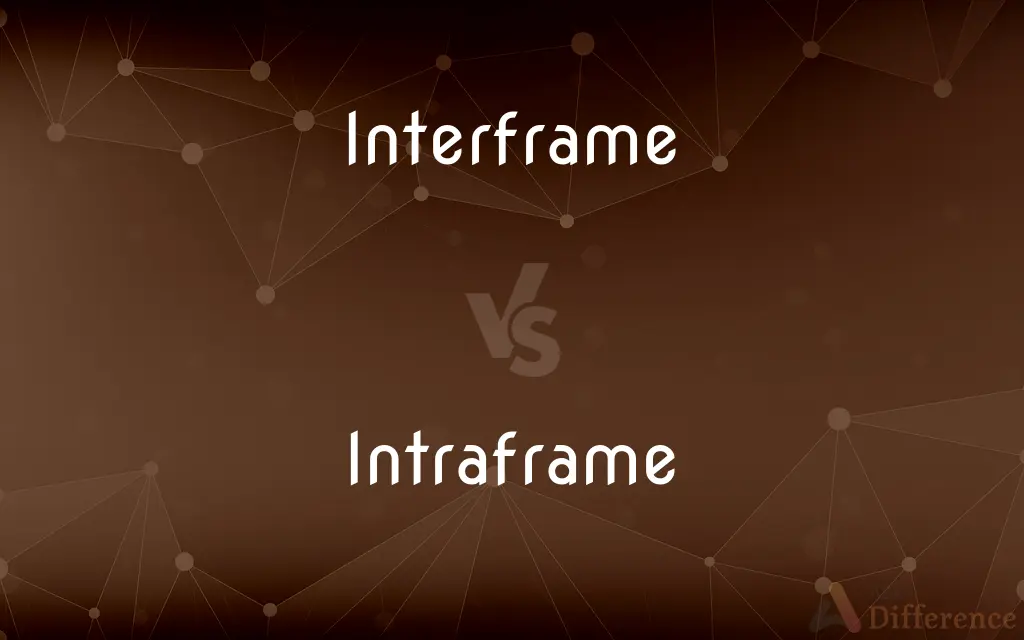Interframe vs. Intraframe — What's the Difference?
By Fiza Rafique & Maham Liaqat — Updated on March 19, 2024
Interframe coding reduces redundancy between consecutive frames, while intraframe coding compresses within a single frame.

Difference Between Interframe and Intraframe
Table of Contents
ADVERTISEMENT
Key Differences
Interframe and intraframe coding are techniques used in video compression to reduce the amount of data required to store and transmit video files. Intraframe coding, also known as I-frame coding, focuses on compressing the data within individual frames by eliminating redundancy within the same frame. It treats each frame as a standalone image, using techniques similar to those used in image compression, such as JPEG. This method is particularly useful for ensuring high quality in still scenes or for enabling random access within a video.
Interframe coding, also referred to as P-frame or B-frame coding depending on the context, reduces redundancy between successive frames. It takes advantage of the fact that in many video sequences, consecutive frames are very similar to each other. Instead of storing complete frame information, interframe coding stores differences between frames or references to similar areas in preceding or following frames. This approach is highly efficient for sequences with minimal changes between frames, significantly reducing the data needed for video sequences.
While intraframe coding ensures that each frame can be decoded independently of others, making it useful for editing and fast-forwarding or rewinding, interframe coding relies on multiple frames for decoding. This dependency improves compression efficiency but makes certain operations, like editing and error recovery, more complex. Intraframe coding is more resilient to errors and data loss; if part of the data is corrupted, it usually affects only one frame. In contrast, in interframe coding, corruption can affect subsequent frames until the next intraframe is reached.
The choice between intraframe and interframe coding depends on the application. For instance, intraframe coding is preferred for still images or when high-quality frame-by-frame editing is required, whereas interframe coding is favored for efficiently transmitting live or recorded video over networks where bandwidth is limited. Video compression standards, like MPEG and H.264, employ a mix of both techniques, using intraframe coding for keyframes and interframe coding for the frames in between to balance quality, efficiency, and the need for random access.
In practice, modern video codecs dynamically adjust the use of intraframe and interframe coding, optimizing for the content of the video, the network conditions, and the desired balance between compression efficiency and image quality. This dynamic approach allows for the efficient handling of diverse video content, from fast-moving action scenes that might benefit more from intraframe coding to slow or static scenes where interframe coding can significantly reduce data rates.
ADVERTISEMENT
Comparison Chart
Compression Type
Between frames
Within a single frame
Techniques Used
Difference coding, motion compensation
Spatial redundancy reduction, JPEG-like compression
Dependency
Depends on other frames for decoding
Frames can be decoded independently
Use Cases
Efficient for video with little change between frames
Suitable for still images or scenes requiring high-quality editing
Error Resilience
Lower, errors can propagate to subsequent frames
Higher, errors usually affect only the corrupted frame
Efficiency
Higher compression efficiency for video sequences
Less efficient for sequences, more for single frames or editing
Compare with Definitions
Interframe
A compression technique that encodes differences between consecutive frames.
Interframe coding is used to efficiently compress the stationary background in a news broadcast.
Intraframe
Utilized for keyframes in video compression standards.
MPEG-4 uses intraframe coding for I-frames, serving as reference points for efficient video playback and editing.
Interframe
Relies on motion vectors and difference frames.
The codec calculates motion vectors for interframe coding to reduce file size.
Intraframe
Suitable for high-quality or editable video content.
Graphic designers prefer intraframe coding for detailed frame-by-frame video editing.
Interframe
Offers significant data savings for videos with minimal changes.
Surveillance footage benefits greatly from interframe coding due to its static scenes.
Intraframe
Compresses video by reducing redundancy within a single frame.
Intraframe coding treats each frame as an independent image, similar to a JPEG file.
Interframe
(signal processing) A video frame which is compressed to express only the change from a reference frame.
Intraframe
(signal processing) A video frame that does not depend on any other frame for rendering, but simply presents a fixed image. Usually subject to spatial compression.
Interframe
A type of bolster for a folding knife.
Interframe
Between frames (of a video file, a network protocol, etc.).
Common Curiosities
How do codecs decide when to use intraframe coding?
Codecs typically use intraframe coding at regular intervals for keyframes and when detecting significant changes in the scene that cannot be efficiently encoded with interframe techniques.
What role do I-frames play in video playback?
I-frames, or keyframes, serve as periodic reset points within a video sequence, allowing for random access and editing. They ensure that decoding can start at any point in the video by providing complete frame information without needing prior frames.
Why is interframe coding less resilient to errors?
Since frames depend on each other for decoding, an error in one frame can affect the decoding of subsequent frames until the next intraframe is reached.
What makes intraframe coding less efficient for video sequences?
Intraframe coding does not take advantage of the similarity between consecutive frames, resulting in higher data rates compared to interframe coding for videos.
Does interframe coding affect video quality?
If not managed carefully, it can introduce artifacts, especially in fast-moving scenes or with poor motion estimation, but modern codecs are designed to minimize these effects.
Why is intraframe coding important for editing?
Intraframe coding allows each frame to be accessed and edited independently without needing to decode surrounding frames, facilitating precise edits.
How does interframe coding achieve higher compression?
By encoding only the differences between frames, interframe coding eliminates redundant data, significantly reducing the overall file size.
Can a video use both interframe and intraframe coding?
Yes, most video compression standards use a mix of both to optimize for quality and compression efficiency.
How do modern video codecs handle scene changes in terms of coding?
Modern codecs detect scene changes and automatically insert I-frames (intraframe coded) at these points, ensuring that the transition between scenes can be encoded without relying on the previous scene's data. This maintains efficiency and quality across scene changes.
How does motion compensation work in interframe coding?
Motion compensation predicts the movement of objects between frames, using motion vectors to describe these changes. This allows the codec to store only the motion information and differences rather than the entire frame, enhancing compression efficiency.
Can desynchronization occur between audio and video due to compression?
Yes, if video compression introduces significant delays or if frames are dropped, it can lead to desynchronization with the audio stream. Effective codec implementations synchronize audio and video to prevent this.
Are there specific environments or applications where intraframe coding is preferred over interframe?
Intraframe coding is particularly beneficial in environments requiring high-quality image preservation and ease of editing, such as professional video editing and archiving. It's also preferred in applications where random frame access is necessary, like surveillance systems with motion-triggered recording.
Share Your Discovery

Previous Comparison
Adverse vs. Inverse
Next Comparison
Jolly vs. HappyAuthor Spotlight
Written by
Fiza RafiqueFiza Rafique is a skilled content writer at AskDifference.com, where she meticulously refines and enhances written pieces. Drawing from her vast editorial expertise, Fiza ensures clarity, accuracy, and precision in every article. Passionate about language, she continually seeks to elevate the quality of content for readers worldwide.
Co-written by
Maham Liaqat















































